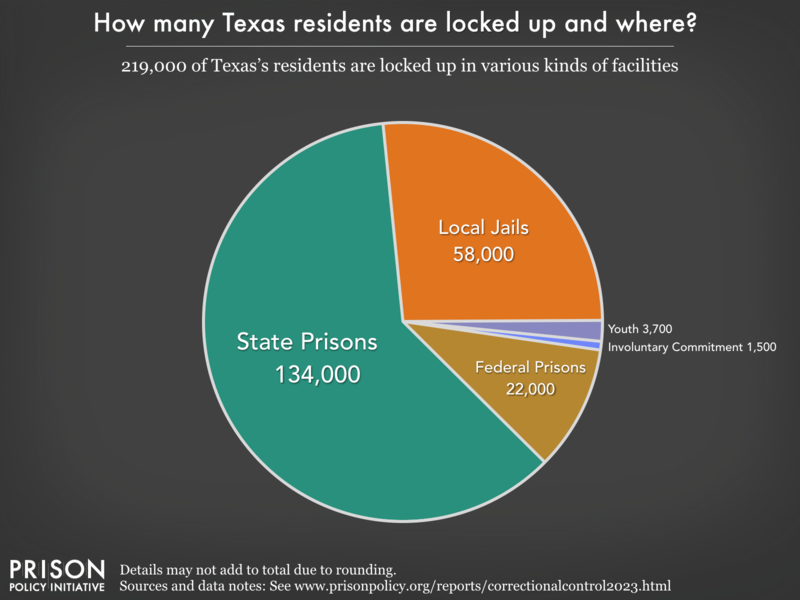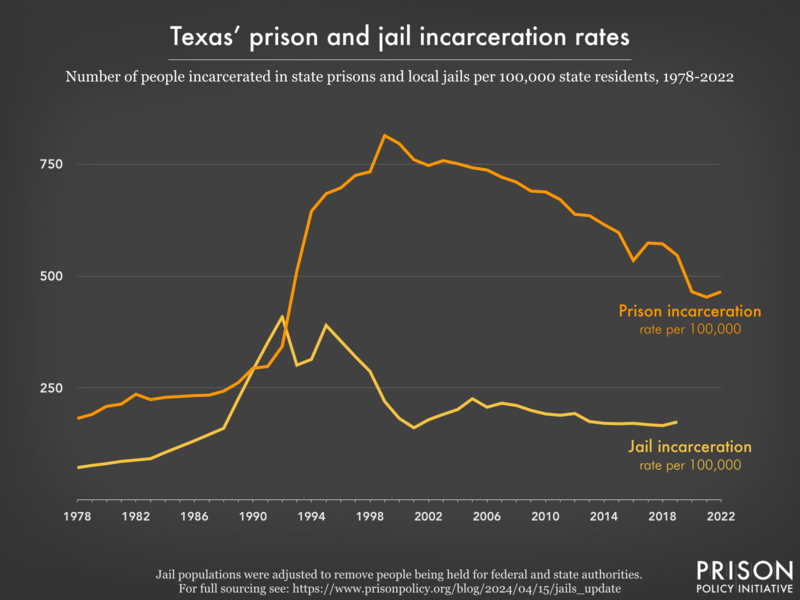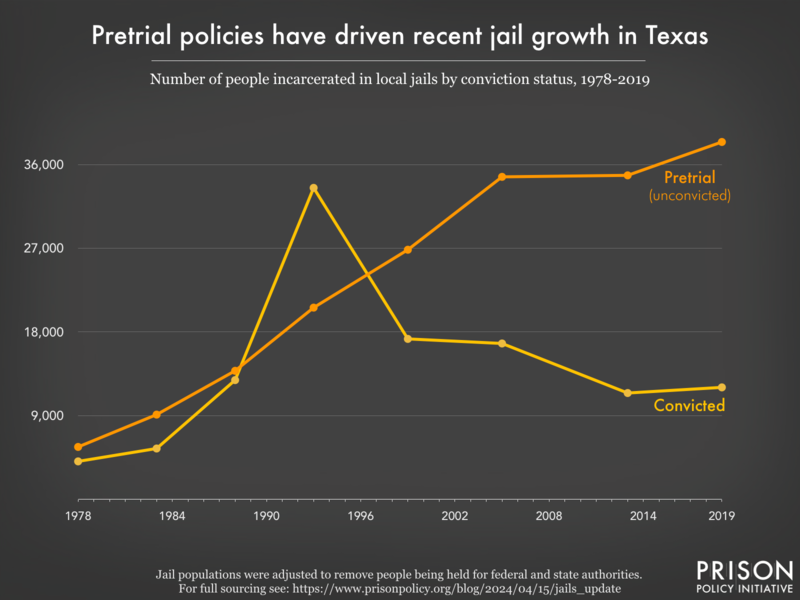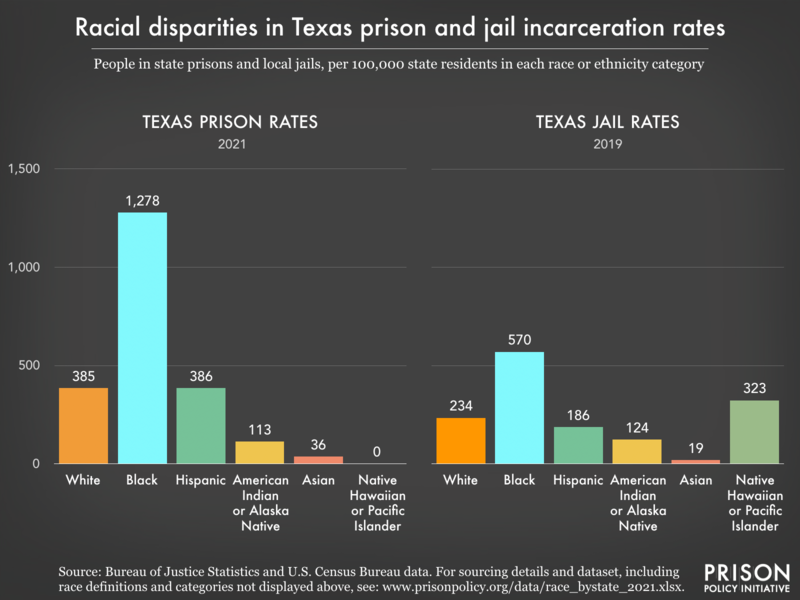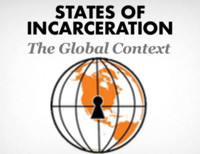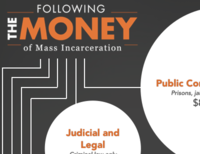Thank you,
—Peter Wagner, Executive Director
Donate
Texas profile
Texas has an incarceration rate of 751 per 100,000 people (including prisons, jails, immigration detention, and juvenile justice facilities), meaning that it locks up a higher percentage of its people than any independent democratic country on earth. Read on to learn more about who is incarcerated in Texas and why.
219,000 people from Texas are behind bars
Additionally, the number of people impacted by county and city jails in Texas is much larger than the graph above would suggest, because people cycle through local jails relatively quickly. Each year, at least 505,000 different people are booked into local jails in Texas.
Rates of imprisonment have grown dramatically in the last 40 years
- total numbers rather than rates.
- Women’s prisons: Incarceration Rates | Total Population
- Men’s prisons: Incarceration Rates | Total Population
Today, Texas’s incarceration rates stand out internationally

People of color are overrepresented in prisons and jails
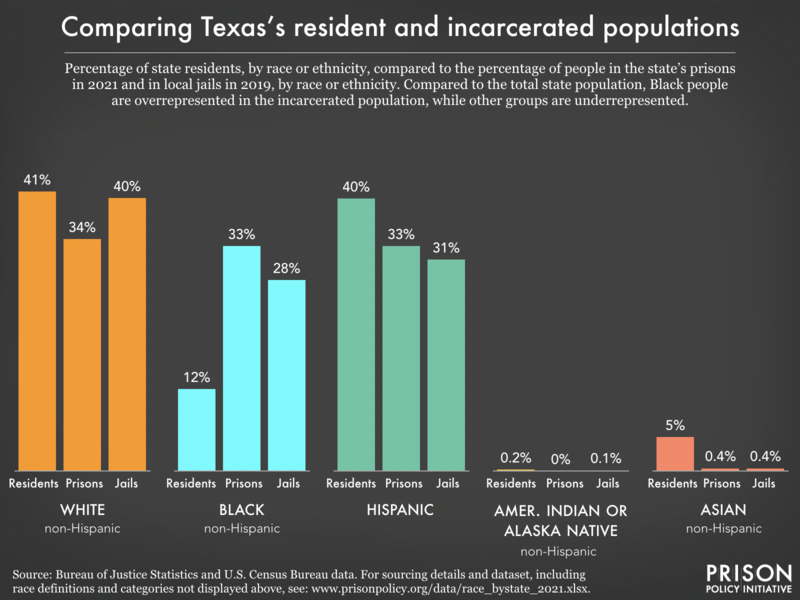
Texas's criminal justice system is more than just its prisons and jails
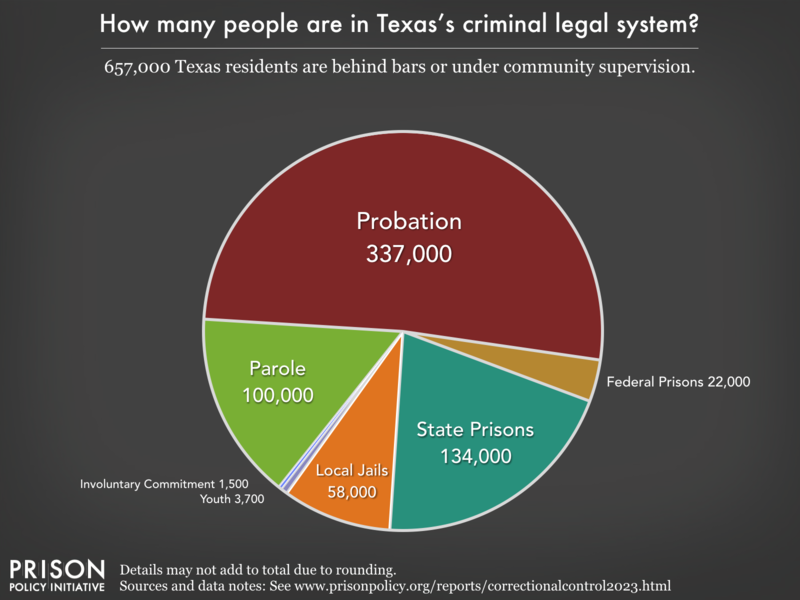
Reports and briefings about Texas's criminal legal system:
Filter to show
- People on probation in Texas are saddled with onerous rules and conditions they must follow every day or risk incarceration.
- Prisons in Texas have tablets, but they may be being used to restrict incarcerated people’s access to books and sap them of the little money they have.
- One small non-profit in Texas is fighting to get answers for families of people who die in jails.
- With an incarceration rate of 751 per 100,000 residents, Texas locks up a higher percentage of its people than any independent democratic country on earth.
- After the Dobbs’ decision, striking down Roe v. Wade, Texas totally banned abortion, putting access to the service effectively out of reach for the 102,587 women on probation or parole in the state who also face travel restrictions.
- Prisons in Texas force incarcerated people and their families — some of the most vulnerable members of society — to subsidize mass incarceration.
- 76% of people in Texas jails have not been convicted of a crime, meaning they're legally innocent. There are simple steps the state can take to reduce this number. Why isn't it?
- Texas releases roughly 844,664 men and 227,778 women from its prisons and jails each year. What is it doing to support them upon reentry?
- Lubbock County, Texas’s jail construction woes should serve as a warning to other communities around the nation.
- The parole board in Texas is releasing 12% fewer people and holding 20% fewer hearings since the pandemic started
- Black people in Texas are incarcerated at a rate 3.3 times higher than white people.
- Texas’s choice to criminalize “failure to appear” may be hurting public safety
- The cost of incarcerating older people is incredibly high, and their risk of reincarceration is incredibly low, yet 15% of people in Texas prisons are over the age of 55. Why is the state keeping so many older people locked up?
- Texas is one of four states that provides privacy protections for incarcerated people communicating with members of the press.
- Texas is one of 20 states that locks up some people convicted of sex offenses in shadowy "civil commitment" facilities, long after their sentences are over — and often indefinitely.
- In Texas, 219,000 people are incarcerated and another 437,000 are on probation or parole.
- Texas charges up to 47¢ for an e-message to or from prison; Among the highest rates in the nation.
- Jails in Texas charge up to $11.25 for a 15-minute phone call, reaping profits for companies, while prisons charge 90¢ for a 15-minute phone call.
- Bail companies in Texas have a track record of avoiding accountability, our report All Profit, No Risk and review of state-by-state evidence show
- Harris County Jail has a jail-based polling location that enables people detained at the facility to cast ballots in elections.
- How the end of Roe v. Wade will impact the 110,704 women on probation and parole in Texas
- In some Texas prisons, incarcerated people are forced to drink and breathe contaminants
- What does successful bail reform look like? To start, look to Harris County, Texas.
- Texas suspended medical copays in prisons at the beginning of the pandemic, but now charges incarcerated people $13.55 to access medical care.
- The poorest people in Texas prisons get some items for free — but they have to pay the state back.
- We do not know how much Texas prisons charge for money transfers — one of the only states we don't have data on.
- We gave Texas a failing grade in September 2021 for its response to the coronavirus in prisons.
- How many COVID-19 cases in Texas communities can be linked to outbreaks in correctional facilities? (data from our report Mass Incarceration, COVID-19, and Community Spread)
- Texas hinders jury diversity by excluding people with felony records and some prior misdemeanors
- Most Texas prisons do not have air conditioning and they charge an exorbitant amount for items that can provide relief from the heat, like fans
- How Texas has reformed its juvenile justice system (from our report Youth Confinement: The Whole Pie)
- We graded the parole release systems of all 50 states — Texas gets an F
- Texas prisons, we've got some questions about your commissary vendors.
- Texas incarcerates women at a rate of 178 per 100,000 residents — higher than any democratic country on earth.
- How bail systems in Texas hurt women
- People in Texas prisons are not paid for their work.
- Texas is 1 of only 8 states still suspending driver's licenses for drug offenses unrelated to driving
- Travis County, Texas: A case study on video visitation
- Victory: In-person visits return to jails in Travis County, Texas!
- Explaining Texas' overnight prison boom
- In-person family visits will return to Austin, Texas
- Dallas County approves video visitation contract
- Dallas County rejects Securus video visitation contract
- Importing Constituents: Prisoners and Political Clout in Texas
- Texas counties favor fairness and common sense over prison gerrymandering
- Avoiding prison gerrymandering is often a matter of common sense: Texas and Louisiana research update
Other resources
- Research on Texas in our Research Library
